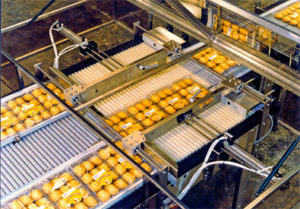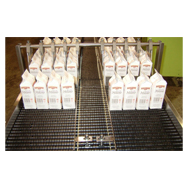In today’s competitive marketplace, food manufacturers must stay on top of the latest in Smart automation and devices that can add value and efficiency to their production lines. Welcome to the world of Slip-Torque by Shuttleworth.
Conveyor systems for handling food products and more are an integral part of the packaging process. The systems of today include smart, advanced roller technology to minimize product damage through the utilization of low back-pressure accumulation. Shuttleworth’s Slip-Torque roller technology provides low line-pressure throughout a continuous-motion accumulation conveyor that allows for precise product placement on the conveyor as it takes product flow from an upstream line for a determined period of time. A low-pressure accumulation buffer absorbs irregularities in the production flow while providing a smooth, even flow on the line.
 Slip-Torque technology uses individually powered, stationary roller shafts covered with loose, segmented rollers which become the conveyor surface. It’s powered by a continuous chain drive to control the driving force of the conveyed product. When the products stop on the conveyor surface, the segmented rollers beneath them also stop – generating low back-pressure accumulation – and minimizing product damage.
Slip-Torque technology uses individually powered, stationary roller shafts covered with loose, segmented rollers which become the conveyor surface. It’s powered by a continuous chain drive to control the driving force of the conveyed product. When the products stop on the conveyor surface, the segmented rollers beneath them also stop – generating low back-pressure accumulation – and minimizing product damage.
The weight of the product being conveyed, combined with the coefficient of friction between the shafts and the inside diameter of the rollers, deliver the driving force. As the weight of the product increases, a corresponding increase in the driving force is supplied. This same conveyor can also be split into multiple, independently operating lanes, as well. For example, the middle lane can accumulate while, at the same time, the right and left lanes can both convey or even run in opposite directions. Even though the lanes can act independently, they are both driven by shared motor – resulting in reduced energy costs.
 These types of conveyors have the ability to modulate the speed of different sections of the conveyor via a central control PLC and HMI. As products are moving down the line, the rollers at the back end of the conveyor can be moving faster than the ones at the front end. Products can also be moving at variable speeds on different sections of the conveyor as dictated by throughput requirements. This helps to control the product spacing on the conveyor, keeping delicate items separated and equally spaced apart in order to minimize product contact and to also facilitate infeed into packaging equipment such as shrink wrappers.
These types of conveyors have the ability to modulate the speed of different sections of the conveyor via a central control PLC and HMI. As products are moving down the line, the rollers at the back end of the conveyor can be moving faster than the ones at the front end. Products can also be moving at variable speeds on different sections of the conveyor as dictated by throughput requirements. This helps to control the product spacing on the conveyor, keeping delicate items separated and equally spaced apart in order to minimize product contact and to also facilitate infeed into packaging equipment such as shrink wrappers.
Motorized rollers are also used to minimize product contact while directing products into desired locations, such as using rollers with herringbone patterns to orient products without the use of guardrails or in setting up a series of sequentially smaller roller heights to direct products into the center of the conveyor for packaging induction without touching any other parts of the conveyor. This technology can be used in elevated temperature applications such as hot products coming out of ovens up to 500F (260C) and in low-temperature applications down to -20F (-29C) for frozen foods such as ice cream.
For more information about Shuttleworth’s surface designs, contact Shuttleworth.Sales@ProMachBuilt.com.
